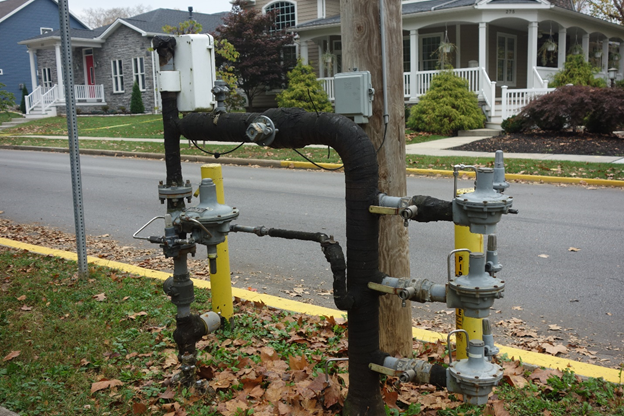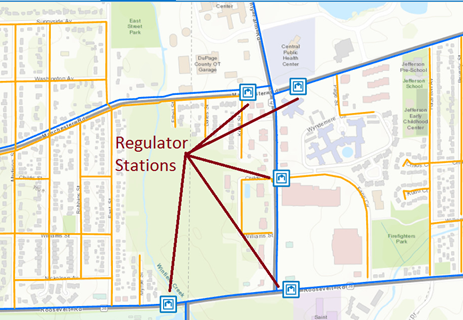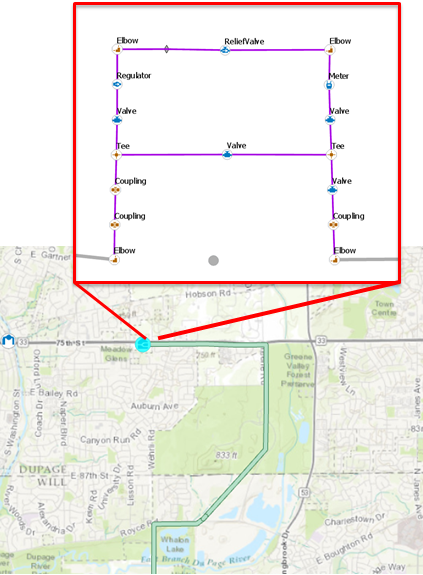- Home
- :
- All Communities
- :
- Industries
- :
- Gas and Pipeline
- :
- Gas and Pipeline Blog
- :
- Utility Network for Gas: Your Angel Is In the Deta...
Utility Network for Gas: Your Angel Is In the Details
- Subscribe to RSS Feed
- Mark as New
- Mark as Read
- Bookmark
- Subscribe
- Printer Friendly Page
Gas Network Complex Facilities Can Be More Fully Defined in the Utility Network
By Tom Coolidge and Tom DeWitte

What if it is really greater goodness that is to be found in having the details of your complex gas network components consolidated in one system of record along with other network data? Think about the improvements to efficiency and productivity that can result when you have all needed data organized in one place and included in your network models. Yes, it’s your angel that we believe lies ahead in the consolidated details. That angel can help you more fully realize the benefits available to you by unlocking the potential of the ArcGIS platform.
Bringing data from disparate sources together on a common geographic basis for visualization and analysis is one of the hallmarks of the Web GIS pattern exemplified by the capabilities of the ArcGIS platform. Increasingly, though, while this advance means that they do not have to, many gas utilities are looking to move a broader range of data now stored elsewhere into today’s modern ArcGIS platform.
Historically, data has been siloed in different systems for many reasons. In the case of detailed data needed to define complex gas components, one of those is that GIS did not provide the functionality needed to define and store that detailed data. That is changing now. This has many benefits for gas utilities. Among those are making it easier to see a holistic view of the network in whatever level of detail is desired and to analyze it, and facilitating interoperation with other application software that rely upon a published definition of the detailed network. At the same time, it reduces the total cost of ownership by consolidating into one system of record what previously was in multiple systems. In a sense, this advance brings GIS closer to operating just as you operate.
That brings us to the Utility Network. One of the Utility Network capabilities getting the most buzz is the capability to more fully define and manage, in real geographic space, the design and operational details of complex gas components, such as regulator stations and compressor stations. The Utility Network opens up new capabilities in leveraging these details to better understand and operate your gas system.
Rest Easy
Before we explore this new capability, let us quickly emphasize that the capability to more fully define complex components does not mean that you ever must! So, rest easy. The choice is yours as to whether you elect to take advantage of the new capability and, if you do, when and to what extent. Moreover, if you do elect to add more detail, you can do it incrementally if you wish, rather than in one big project.
Before Now
Before the release of the Utility Network, complex gas components typically were represented in ArcGIS as a point feature. Historically, CAD software often has been used to create precision drawings of gas network complex components. With CAD, what you see is basically what you get – just a picture, not usable data. ArcGIS delivers much more. You still can see the same thing, but what you see is just a representation of the data behind it which you can use in many powerful ways. Now instead of looking at a picture of the internals of a gas facilities you can interact and ask questions of the gas facility details. What kind of questions might you be asking of the details? In an emergency operation instead of an isolation trace stopping at the simple representation of a gas facility such as a regulator station, it can now identify the specific critical valves within the facility which need to be closed. If a recall is issued for a specific manufacturer device or fitting, and that device or fitting was installed within a gas facility, those gas facility components can now be identified and reported. Answering these types of questions is not possible when the gas facility internals are just a picture.
How Much Detail
We increasingly are asked how detailed should the definition in ArcGIS be of a gas network?
There is no one answer to that question. With the ArcGIS platform increasingly supporting the mapping and spatial analytics needs of a growing number of users in a broader range of gas utility functional areas and roles, the answer to that question is evolving.
Here is one way to look at it. The answer to what needs to go into your geodatabase largely depends on what you want to get out of it. That is because each software application has its own specific data requirements. If you want your geodatabase to support one application, then only that application’s data requirements need to be accommodated. If you want your geodatabase to support two applications, then the data requirements of both need to be accommodated. And, so on. While some applications share data requirements, generally as the number of applications to be supported increases, so, too, does the breadth and depth of data requirements. The key to your answer lies in understanding the number of applications to be supported and their combined data requirements.
Remember the title of this blog, “Your Angel Is In The Details?” As a rule, erring on the side of more detail is a good thing. It is easier to simplify a more detailed definition than it is to add detail to less detailed one.
An Example
One of the functional areas now more fully exploiting ArcGIS capabilities is gas operations.
Analytics for gas operations often require more granular data than analytics for other functional areas.
Let’s consider regulator stations. Gas networks typically include multiple sub-networks, each operating at up to a different maximum pressure, with pipe sizes and maximum pressures reducing the closer gas gets to delivery points. Regulators control the safe reduction of pressure or flow from a higher pressure sub-network to a lower one. A regulator station can be simple, with a single regulator on a single path. Or it can very complex, with multiple regulators and other devices on multiple paths. It also likely contains safety devices. These safety devices may include additional regulators, relief valves, and remote monitoring equipment.
In ArcGIS, a regulator station traditionally has been defined as a point feature. In reality, a regulator station is a complex facility. Now, in the Utility Network you can define those design and operational details.


Technical Discussion
Since gas systems were originally mapped in a GIS several decades ago, GIS professionals have struggled to get the balance right between needed detail and desired cartography. One example of this struggle is the need to manage geographically condensed features like those contained within a gas facility. These details can create very cluttered and hard-to-understand map displays.

As already stated, these details need to be more than just a picture. They need to be asset records. These asset records need to be spatially reportable so gas companies know where gas devices and fittings are located. Then, add to these gas facility data management requirements the gas operations requirement that these gas facility details be traceable. This is to aid gas ops staff during emergency operations to not only know that a valve in a gas facility needs to be closed, but to identify which critical valve(s) in the gas facility need to be closed. The solution to these problems is the new Utility Network and its container capability.
So what is a container
A container is an association between the individual features representing the assets internal to a gas facility with the single point feature representation of the gas facility.
Once the container association has been established, the contained assets are hidden from the standard map display. Similar to the legacy picture representation, users are able to click on the simple gas facility representation and see the internals of the gas facility in a separate map window.

What reporting can I do
The assets contained within a container are geospatial features stored in geodatabase featureclasses. Standard database reporting tools, whether ArcGIS-based or Business Intelligence-based can be used to query, summarize and report these on features. But, what about spatially querying these featureclasses with a standard ArcGIS tool like “Select Features by Location”? This is an additional type of supported reporting, because the Utility Network provides the ability to precisely place the internal assets at their true geographic location within the gas facility. This is a key point, so let me repeat. Internal assets are placed at their true geographic location!
Can I trace these gas facility assets
With the Utility Network, all container contained assets participate in the overall pipe system’s network topology. This means, for instance, that during a gas emergency operation, an isolation trace task can be performed to identify the critical valves within the gas facility which need to be closed for the emergency. This improvement in modeling complex gas facilities additionally provides a better understanding of cathodic protection areas, pressure zones, and system zones.
The Utility Network Management extension container capabilities provides a solution to the gas industries growing needs for better management of the details of gas facilities. This ability to manage gas facility internal assets as features instead of pictures, allows gas organizations to provide clear and concise maps, without sacrificing the ability to model individual assets. Containers provide the angel that gas organizations have been looking for to solve the problem of managing a gas facilities details.
PLEASE NOTE: The postings on this site are my own
and don’t necessarily represent Esri’s position, strategies, or opinions.
You must be a registered user to add a comment. If you've already registered, sign in. Otherwise, register and sign in.